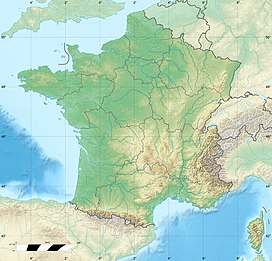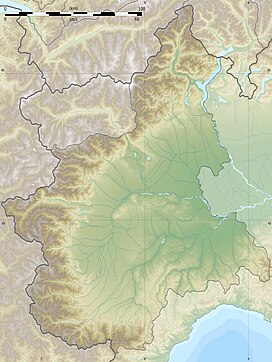The Chambeyron massif (French: Massif de Chambeyron, Italian: Gruppo del Chambeyron) is a massif in the Alps, straddling between France and Italy, between the Escreins Massif, the Cottian Alps and the Mercantour-Argentera massif. It occupies the high valleys of Ubaye, Maira, Varaita and Stura di Demonte.[1]
| Chambeyron Massif | |
|---|---|
 The Chambeyron Massif and the north face of Aiguille de Chambeyron | |
| Highest point | |
| Elevation | 3,412 m (11,194 ft) |
| Parent peak | Aiguille de Chambeyron |
| Coordinates | 44°32′21″N 6°49′38″E / 44.5390788°N 6.8272953°E |
| Naming | |
| Native name | |
| Geography | |
| Country | |
| Region | |
| Geology | |
| Age of rock | Cretaceous to Pre-Permian |
Main summits
editThe main peaks are:
- Aiguille de Chambeyron, 3,412 m
- Brec de Chambeyron, 3,389 m
- Bric de Rubren, 3,340 m
- Pointe d’Aval (or Chauvet), 3,320 m
- Pic du Pelvat, 3,220 m
- Tête de Malacoste, 3,216 m
- Brec de l’Homme, 3,211 m
- Pointe-Haute de Mary, 3,206 m
- Roche Blanche, 3,193 m
- Pointe du Fond du Roure, 3,184 m
- Dents de Maniglia, 3,183 m
- Tête de Sautron, 3,165 m
- Pelvat de Chabrière, 3,157 m
- Tête de la Fréma, 3,151 m
- Cima di Pienasea, 3,132 m
- Pointe-Basse de Mary, 3,126 m
- Serrière de la Testera, 3,126 m
- Tête de Moïse, 3,104 m
- Monte Ferra, 3,094 m
- Pelvo d’Elva, 3,064 m
- Monte Faraut, 3,046 m
- Monte Chersogno, 3,026 m
- Cima Sebolet, 3,023 m
- Rocca Bianca, 3,021 m
Geology
editThe massif is part of the Internal Alps and it is mainly made up of sedimentary rocks, notably dolomitic limestones and shale.[2]
Glaciation
editThe Chambeyron massif is very lightly glaciated. Most glaciers are disappearing, or have disappeared during the 20th century. Only the Marinet glaciers (north face of the Aiguille de Chambeyron), as well as the Chauvet glacier, remain.[3]
References
edit- ^ Bulletin de la Société géologique de France (in French). La Société. 1957.
- ^ "Haute vallée de l'Ubaye - Massif de Chambeyron - Rochers de Saint-Ours - Tête de Moïse". Inventaire National du Patrimoine Naturel (in French). Retrieved 2024-06-03.
- ^ Griselin, Madeleine (1995). 3e symposium international, cavités glaciaires et cryokarst en régions polaires et de haute montagne: Chamonix-France, 1er-6 novembre 1994 : actes (in French). Presses Univ. Franche-Comté. ISBN 978-2-251-60561-6.



